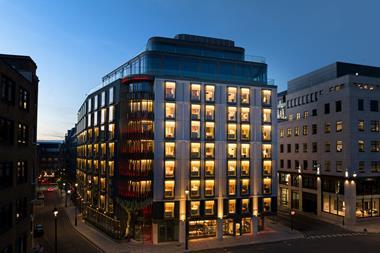Private investors, namely ultra-high net worth individuals (UHNWIs) and family offices, are set to snap up London office assets worth £2.4 bn (€2.7 bn) in 2023, 60% more than they did last year, new research from advisor Knight Frank revealed.

The cash rich investor group, who are generally less reliant on debt to finance transactions, are expected to be in a strong position to take advantage of the reduced competition from larger institutional buyers.
Private investors have historically accounted for 20% of London office transactions and Knight Frank predicts this number to rise in 2023 to 25%. Having made acquisitions worth £1.5 bn in 2022, they have set aside £3.4 bn in the hunt for investment grade London office assets this year.
Knight Frank’s survey of global private investors and wealth advisors with $2.5 trl of private capital, found that four out of 10 UHNWIs managed to increase their wealth in 2022. Furthermore, 46% identified real estate as the top investment opportunity this year for wealth protection and income growth in the current inflationary environment. Around 20% of global UHNWIs have plans to make direct investments into real estate this year.
Overall, this year is expected to see £9.5 bn of global capital deployed into London offices, underpinned by expectations of positive rental growth for prime buildings. Transactions are expected to be dominated by Asia-Pacific based investors, particularly from Singapore and Australia, who are predicted to allocate £4 bn into office buildings in the UK capital, accounting for 42.5% of this year’s expected turnover. They are followed by European investors, who are expected to add £2.3 bn worth of assets to their London office portfolios, and North American investors who are set to snap up deals worth £1.7 bn.
‘London’s prime office assets continue to offer stable rental growth despite a challenging macroeconomic backdrop, as occupiers seek more sustainable buildings that will help them to attract and retain talent,’ commented Philip Hobley, head of London Offices at Knight Frank. ‘We are seeing unprecedented polarisation between ‘the best’ and ‘the rest’, with a shortage of prime office space and a risk of many lower quality, less sustainable assets becoming stranded or obsolete. Rising debt and construction costs have further weakened the development pipeline, which will intensify the competition for buildings that offer the best ESG credentials and workplace experience. Even if occupier demand was to moderate in 2023, this would be more than compensated for by a constrained pipeline.’
Globally, the weight of money targeting London offices is £43.8 bn, significantly higher than the available institutional grade stock. This is based on planned allocations to London offices from global institutions, private equity firms, pension funds and private investors, considering their respective capital deployment targets.
Buyers from Asia-Pacific hold the highest levels of investable capital, with £19.3 bn, representing 45% of the global total. This is driven by China’s reopening and confidence that the UK’s inflation levels, and long-term interest rates, will continue to decline over 2023. Singaporean investors are expected to lead capital flows from Asia-Pacific, with £4.8 bn waiting on the wings for opportunistic purchases. They are followed by buyers from South Korea’s state investment funds (£1.6 bn), Japan (£1 bn) and Australia (£1 bn). Meanwhile, domestic investors from the United Kingdom have set aside £4.6 bn, 10.5% of the global total.
Investor sentiment is underpinned by robust levels of occupier demand for new or comprehensively refurbished workspaces with strong ESG ratings and wellbeing credentials. This continuing trend saw central London office take up rise 24% in 2022, totalling 11.5 million sq ft. Demand for best-in-class, green-rated offices was up 33% year-on-year, reaching 6.8 million sq ft, representing 60% of total take up.
With 2.7 million sq ft of deals currently under offer, London is expected to experience a 11 million sq ft shortfall of best-in-class office space between now and 2026. This is based on a visible development pipeline of 15.5 million sq ft, of which 4.4 million sq ft has been pre-let, with average take up of new and refurbished Grade A space standing at 5.6 million sq ft per annum. This acute shortage is expected to drive uplifts in prime rents.
Nick Braybrook, head of London Capital Markets at Knight Frank, commented: ‘After a period of repricing, we expect deal volumes to recover in 2023, as yields for the very best prime London assets have now stabilised. While a wider economic slowdown is expected in the UK, investors are attracted to knowledge and innovation driven economies offering sustainable investments. This is one of London’s strengths, with its burgeoning life sciences and innovation sectors being a major driver of growth and a strong source of leasing activity. Inflation is expected to peak in 2023 and real estate weightings in portfolios could exceed target levels because of the relative under-performance of other asset classes.’









